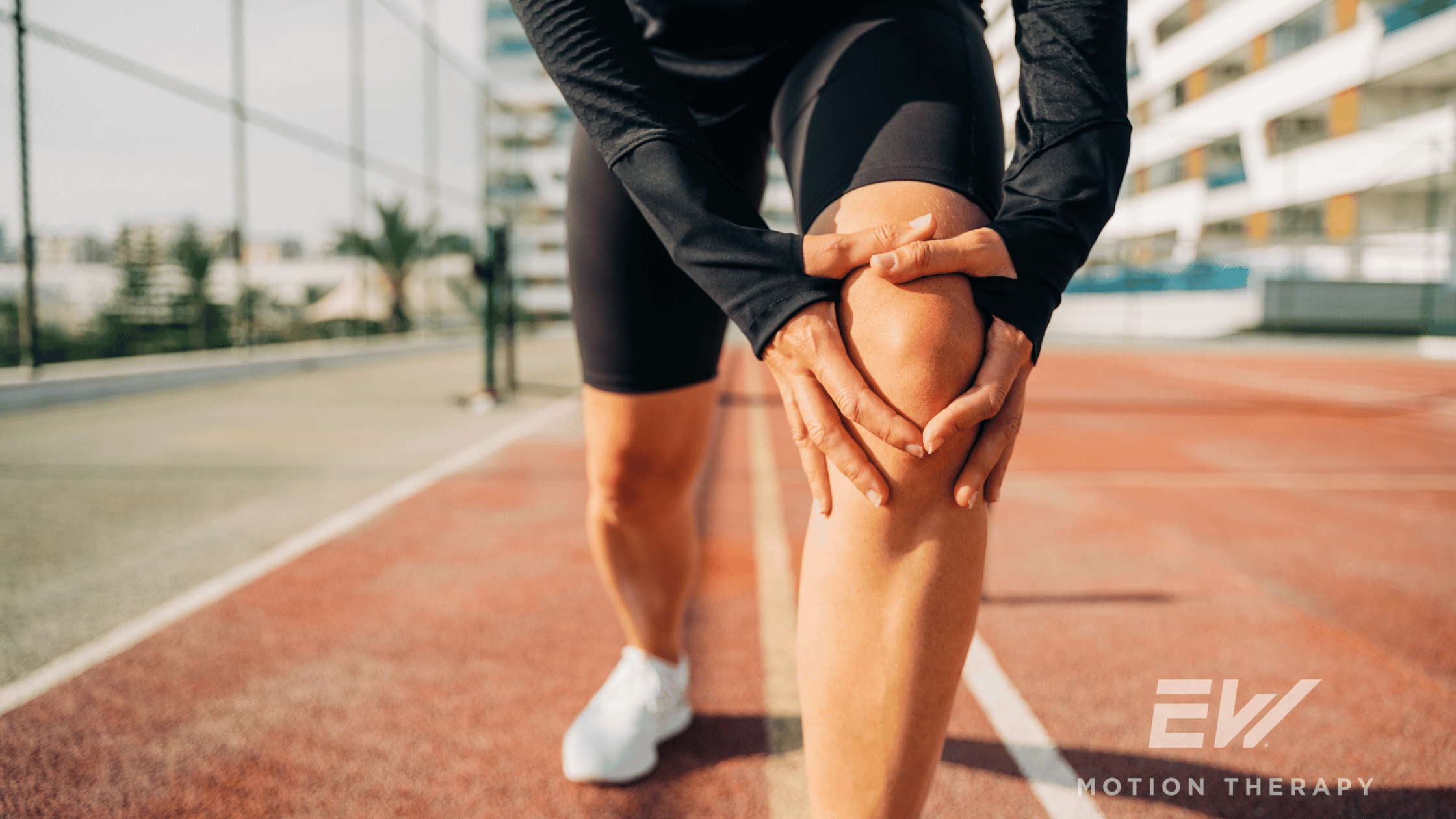Understanding Runner's Knee: Causes, Symptoms, and Effective Treatment Options

Licensed Physical Therapist, PT, DPT // EW Motion Therapy Homewood
Running is a beloved activity for many, offering both physical and mental benefits. However, for some runners, persistent knee pain can turn a pleasant run into a painful ordeal. One of the most common issues faced by runners and other athletes is a condition known as runner's knee, or patellofemoral pain syndrome (PFPS). This condition, characterized by pain around the kneecap, can significantly hinder your ability to engage in not only running but also other activities that involve knee movement. Understanding the causes, symptoms, and treatment options for runner's knee is essential for managing it and returning to your regular activities with confidence.
What is runner's knee?
Runner's knee, medically known as patellofemoral pain syndrome (PFPS), is a common condition that affects runners and other athletes who engage in activities involving repetitive knee motion. Despite its name, runner's knee doesn't just affect runners. It can impact anyone who participates in activities that stress the knee joint, such as cycling, jumping, or even walking.
Runner's knee refers to pain around or behind the kneecap (patella) and often results from irritation of the cartilage on the underside of the patella. The pain can range from mild discomfort to a sharp, debilitating pain that limits activity. Understanding the causes and symptoms of runner's knee is crucial for effective treatment and prevention.
Symptoms of runner's knee
The runner's knee manifests various symptoms, primarily centered around the kneecap. Key symptoms include:
- Pain around the kneecap: The most common symptom is a dull, aching pain around or behind the kneecap. This pain often worsens during activities that involve bending the knee, such as running, squatting, jumping, or using stairs.
- Swelling: Mild swelling around the knee joint may occur, contributing to discomfort.
- Popping or grinding sensation: Some individuals may experience a popping or grinding sensation in the knee when moving, especially during activities that involve bending and straightening the knee.
- Increased pain with prolonged sitting: Sitting for extended periods, especially with bent knees, can exacerbate the pain, a phenomenon often referred to as "theater sign."
These symptoms can vary in intensity and may worsen over time if not appropriately addressed. Identifying and treating the underlying causes is essential to alleviate pain and prevent further damage.
Common causes of runner's knee
Runner's knee is typically caused by overuse, improper technique, or biomechanical issues that place excessive stress on the knee joint. Some of the most common causes include:
- Overuse: Repetitive stress on the knee joint from activities like running, jumping, or cycling can wear down the cartilage, leading to irritation and pain.
- Misalignment: If the patella is not properly aligned within the groove of the femur, it can cause uneven pressure on the cartilage, leading to pain. Misalignment can result from structural issues with the ankles or feet, or from muscle dysfunction, such as weak hips.
- Weak or tight muscles: Weakness or tightness in the muscles around the knee, particularly the quadriceps, hamstrings, and hip muscles, can contribute to improper patella tracking, leading to runner's knee.
- Inadequate footwear: Worn-out or improper footwear that doesn't provide adequate support can exacerbate biomechanical issues, increasing the risk of runner's knee. Shoes are not exactly a direct cause of the condition but can contribute to other problems that may lead to runner’s knee.
- Improper training techniques: Sudden increases in activity intensity or duration, or improper running form, can place undue stress on the knees.
Understanding these causes is key to both treating and preventing runner's knee. Addressing the root of the problem can significantly reduce pain and allow for a return to normal activity.
Treatment options for runner's knee
Treating runner's knee involves a combination of home remedies, lifestyle modifications, and, in some cases, professional interventions like physical therapy. Here are some effective treatment options:
Rest and activity modification
One of the first steps in treating runner's knee is to rest the affected knee and avoid activities that exacerbate the pain. While complete rest is not always necessary, modifying activities to reduce knee stress can help. For example, switching from running to low-impact activities like swimming or cycling can provide relief while maintaining fitness.
Ice therapy
Applying ice to the knee can temporarily help reduce pain and swelling. During the initial stages of pain, ice should be applied for 15-20 minutes every few hours. It’s important to avoid direct contact with the skin by wrapping the ice pack in a cloth or towel.
Compression and elevation
Using a compression bandage can help reduce swelling while elevating the knee above heart level can decrease inflammation. Both techniques are beneficial in the early stages of treatment.
Pain relief medication
Over-the-counter nonsteroidal anti-inflammatory drugs (NSAIDs), such as ibuprofen or naproxen, can help reduce pain and inflammation. However, these should be used with caution and under the guidance of a healthcare provider, especially for prolonged periods.
How physical therapy can help with runner's knee
Physical therapy is crucial in treating runner’s knee, especially for individuals with persistent symptoms or biomechanical issues contributing to the condition. A physical therapist can provide a personalized treatment plan that includes:
Biomechanical assessment
A physical therapist can assess your gait, posture, and movement patterns to identify any underlying issues contributing to runner's knee. This assessment helps tailor treatment to address specific problems, such as improper running form or muscle imbalances.
Targeted exercise program
Physical therapists can design a targeted exercise program to strengthen weak muscles, improve flexibility, and enhance knee stability. These exercises are often more specific and effective than general home exercises.
Strengthening and stretching exercises targeting the muscles around the knee, particularly the quadriceps, hamstrings, and hip muscles, can help improve knee alignment and reduce pain. Key exercises include:
- Quadriceps strengthening: Exercises like straight leg raises and quad sets can help strengthen the muscles that support the knee.
- Hamstring stretches: Stretching the hamstrings can relieve tension that contributes to knee pain.
- Hip abductor strengthening: Exercises like clamshells and side leg raises can help improve hip strength, which in turn supports better knee alignment.
- Foam rolling: Using a foam roller to release tight muscles around the knee can also be beneficial.
- Manual therapy: Techniques such as massage, joint mobilization, and soft tissue manipulation can help reduce pain and improve mobility in the knee.
Education and injury prevention
Physical therapists can provide education on proper techniques for running, stretching, and strength training, as well as advice on choosing the right footwear and managing training loads to prevent future injuries.
Progressive return to activity
A physical therapist can guide a gradual return to running and other activities, ensuring that the knee is sufficiently strengthened and conditioned to handle the demands of these activities without causing a recurrence of symptoms.
Runner's knee is a common yet manageable condition that can be effectively treated with a combination of home remedies, lifestyle modifications, and physical therapy. Understanding the symptoms and causes of runner's knee is crucial for timely and effective treatment. By addressing the underlying issues and following a comprehensive treatment plan, individuals can reduce pain, improve knee function, and return to their favorite activities without fear of re-injury.
If you're struggling with runner's knee, consider consulting a physical therapist who can provide a personalized treatment plan tailored to your needs. With the right approach, you can overcome runner's knee and continue enjoying an active, pain-free lifestyle. We love helping our runners at EW Motion Therapy recover from injuries like runner’s knee so they can get back to the sport they love. To learn more, click the button below to download our answers to 20 frequently asked questions.


